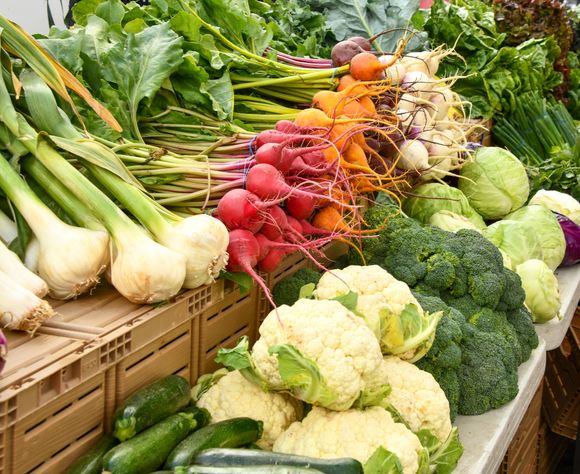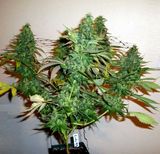Author: Sylvia Marinova, PhD student in the Laboratory "Genomic Stability" at BAS
In the family of cruciferous crops (Brassicaceae) fall many of the vegetables that one could find on the market. Cabbage, broccoli, cauliflower, curly cabbage (kale), turnips, arugula and Brussels sprouts are just some of them. Even wasabi and whiste mustard belong to that family. It is extremely rich in species - some of the most nutritious vegetables in our menu, often called "superfoods), belong to it."
There are certain cases though where we need to be careful with the consumption of Brassicaceae vegetebles. We will examine the good and bad sides of them with focus on broccoli.
What do cruciferous vegetables contain
Cabbages are among the vegetables with the highest protein content. Besides that they are a source of carbohydrates, fibers and many vitamins (folic acid, provitamin A, vitamin C and vitamin E).
100 g of fresh broccoli [ref.1] are known to contain 2.8 g of protein, and in curly cabbage (kale) - as much as 3.2 g. Vegetables of this family also contain the microelements calcium, phosphorus, magnesium, sodium, potassium, iron, manganese, copper, selenium and zinc.

The healing properties of cruciferous vegetables are due to their secondary metabolites
In plants secondary metabolites are compounds that are not vital to their existence, but have to do with their interaction with the environment and their response to external stimuli. It is the secondary metabolites produced by plants that are of medicinal interest . Many of them have healing properties and have been known to man since ancient times.
Cabbage vegetables produce many secondary metabolites, which are are responsible for their health benefits, except, of course, their nutritional value and the variety of vitamins and minerals that cabbage crops offer to us. However, some of them have another side that needs to be approached with caution.
A large class of secondary metabolites contained incruciferous vegetables are sulfur compounds. The most important of these are glucosinolates, which are broken down by enzymes either in the plants themselves, or from our intestinal microflora to active thiocyanates, isothiocyanates and nitriles. Glucosinolates are responsible for the specific bitter and sometimes spicy taste of these plants. Their functions include antibacterial, antifungal, and anticancer [ref.2]. Unfortunately, as we will see below, these compounds are a double-edged sword and should be consumed with caution by people who suffer from thyroid dysfunction.

Other important compounds we may find in broccoli and this family as a whole are the phenolic compounds such as tanins, phenolic acid, cumarins and flavonoids. For example some of the strong antioxidant properties of broccoli are due to the high phenolic acid content - in a dry mass of broccoli per gram, there are 8.69 mg it. From the flavonoids one could find quercetin and kaempherol, known for their strong antioxidant activity [ref.3] .
Cabbage plants are also a good source of phytosterols, which are known for their cardioprotective (protecting the heart) and anticancer function.
Health benefits of broccoli
As we have seen in the above section, broccoli and cruciferous have a rich arsenal of active ingredients, the health benefits of which are a subject of extensive scientific research. Among the best studied effects on the body are:
- Anti-cancer - a series of studies as early as the 80s and 90s of the last century showed a decrease in the risk of developing various types of cancer such as colon, pancreas, lung, prostate, ovaries and breast cancer [ref.1]. The anti-cancer effects are mainly due to the isothiocyanate content like suphorane.
- Improves digestion - broccoli, like other family representatives, is known to improve peristalsis (motility) of the intestine, which favors regular bowel movements [ref.4]. It is important to note that the cited study covers healthy people who do not suffer from irritable bowel syndrome (IBS) or other disorders of the digestive system.

- Reduces the risk of diabetes type 2 and cardiovascular diseases- there are numerous studies on the effects of diet on the risk of developing diabetes and diseases of the cardiovascular system, as well as on the overall conditioning of the body. Eating vegetables rich in fiber and nutrients such as broccoli is a highly recommended part of a healthy menu.
How to consume broccoli
As mentioned above, isotiocyanates are activated compounds that are produced by their predecessors glucosinolates. This is done under the influence of the enzyme mirosinase contained in broccoli. It is released when the surface of the plant is injured, which means that broccoli must be cut or chewed when consumed in order to activates beneficial ingredients.
Here we should keep in mind that heat processing inactivates myrosinase, which makes it difficult to absorb glucosinolates. Luckily, our little friends - bacteria in the gut - can also secrete enzymes that have a similar activating effect. If we choose the processed option, then steaming is the best solution, as it allows to preserve more of the useful ingredients in the vegetable itself.
Read more in the article .

An interesting fact is that young broccoli sprouts contain 10 to 100 times more glucosinolates [ref.1] , which makes them a much more concentrated source. For this reason, their use is becoming more widespread, and some classify them as "superfoods". It is also high in seeds [ref.5] as well as in food supplements, of course.
Read more in the article the .
When to be careful
Despite the many benefits of glucosinolates and strong anticancer potential, they should be approached with caution.
Activated glucosinolates can have a very strong antithyroid effect . This means that they suppress the action of the thyroid gland by interfering with the synthesis of iodine-containing hormones. If you have problems with thyroid function, it is mandatory to consult a medical person regarding changes in diet.
Read more in the article .
On the other hand, broccoli and some other cabbage plants are known to cause symptoms that are associated with the Irritable Bowel Syndrome (IBS). Since they are gas-forming and difficult to digest , they often lead to deterioration of the condition. However, their undeniable positive effects should not be ignored, and people suffering from such disorders should find the balance in their consumption. Sometimes the amount or the thermal treatment may prove decisive.








